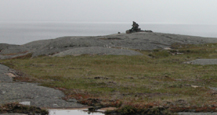Volume 10, Issue 02
May 2007
bulletin
français

| Subscription information If you would like to subscribe, have any questions or if would like to contribute a news item, please contact Yann Vergriete, newsletter editor or David Gailbraith, CBCN executive director: yannvergriete@fastmail.fm dgalbraith@rbg.ca |
|
5. Biodiversity, climate change, and cultural diversity, Alain Cuerrier, Jardin Botanique de Montréal
Most people, researchers and laymen alike, view biodiversity in terms of biology without giving due consideration to First Nations and their cultural components. More and more publications and studies acknowledge the importance of putting culture in the biodiversity equation. But the merging of scientific and traditional knowledge is still far from equal. The balance shifts inexorably towards science which then reduces tradition to a mere quotation of good will. In the Convention on Biodiversity (CBD), cultural diversity has also been established as an important role (see Art. 8j). Not only are rare, endangered or vulnerable species to be protected but so are medicinal species and, moreover, species used in ritual or those who have simply a local, social importance. In order to protect any taxon, it is essential to make use of all available data. How many biologists today can truthfully say that they have consulted local people, whether indigenous or not? How many reserves, parks, and protected areas have been established with the help of indigenous and local people? It is still quite surprising to hear First Nations people listing organisations such as the WWF and the IUCN among their potential enemies. How would you feel if an organisation declared your backyard a nature reserve in which your seasonal activities are suspended? Of course, we learn from our mistakes and both international organisations cited above have now incorporated an indigenous aspect to their mandate. First Nations possess a long history of respecting Nature. When asked about the population of beavers or belugas in a determined area, Inuit may well estimate a closer number than researchers using scientific methodology. Now, with climate change being one of today’s most imminent threats, the use of accurate data based upon all possible knowledge should permeate our work. Integrating Inuit knowledge in addressing climate change may lead to a better understanding of the multiple impacts it will have on the arctic environment. It can help to focus our attention on precise problems pinpointed by the native communities. Indeed, Inuit have voiced that a month was missing in their calendar due to global warming. They are also aware of new birds and insects migrating to their land, animals not seen before and for which they have no words in Inuktitut. Vegetation changes (composition and pattern of shrub/tree distribution), animal behaviour, distribution, and demography and ice and water movement can be addressed starting with traditional ecological knowledge. This is not only a case of humility but also of common sense. There is a future for science and tradition to walk hand in hand. Let’s use both. After all, aren’t we all part of Nature through our biological essence and our cultural identity? With little time left to grasp climate change, its impact on biodiversity (and cultural diversity!) and to postpone the unforeseen to maintain earth as a living space, it is only logical to work together with the local people living in the Arctic who are at the forefront of actual changes. Two heads are better than one. Biodiversity is also diversity of opinions. It’s a richness… and an enjoyable one!
|


